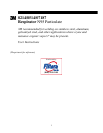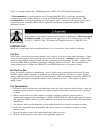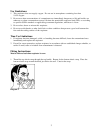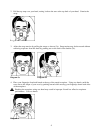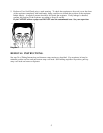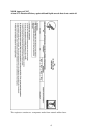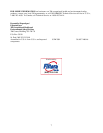
2
07187 is a catalog number only. NIOSH approved as 3M™ 8214 N95 Particulate Respirator.
* 3M recommended for ozone protection up to 10 times the OSHA PEL or applicable government
occupational exposure limits, whichever is lower (not NIOSH approved for use against ozone). 3M
recommended for relief against nuisance levels of organic vapors. (Nuisance level organic vapor refers to
concentrations not exceeding OSHA PEL or applicable government occupational exposure limits,
whichever is lower.)
This respirator helps protect against certain airborne contaminants. Misuse may result
in sickness or death. For proper use, see supervisor, or User Instructions, or call 3M
in U.S.A., 1-800-247-3941. In Canada, call Technical Service at 1-800-267-4414.
IMPORTANT:
Before use, wearer must read and understand these User Instructions. Keep insert for reference.
Use For:
Solids such as those from processing minerals, coal, iron ore, flour, and certain other substances. Liquid
or non-oil based particles from sprays that do not also emit oil aerosols or harmful vapors. Metal fumes
produced from welding, brazing, cutting and other operations involving heating of metals. Organic vapors
below the OSHA PEL or applicable government standards, whichever is lower. 3M recommended for
ozone protection up to 10 times the OSHA PEL (not NIOSH approved for use against ozone).
Do Not Use For:
Gases, oil aerosols, asbestos or sandblasting. Aerosol and/or ozone concentrations that exceed 10 times
the PEL, specific OSHA standards, or applicable government regulations, whichever is lower. Organic
vapors, including those present in paint spraying operations, when concentrations exceed the OSHA PEL
or applicable government occupational exposure limits, whichever is lower. This respirator does not
supply oxygen.
Use Instructions:
1. Failure to follow all instructions and limitations on the use of this respirator and/or failure to wear this
respirator during all times of exposure can reduce respirator effectiveness and may result in sickness
or death.
2. Before occupational use of this respirator a written respiratory protection program must be
implemented meeting all the requirements of OSHA 29 CFR 1910.134 such as training and fit testing
and applicable OSHA substance specific standards. In Canada, CSA standard Z94.4-93 requirements
must be met.
3. The particles which can be dangerous to your health include those so small you cannot see them.
4. Leave the contaminated area immediately and contact supervisor if dizziness, irritation, or other
distress occurs.
5. Store the respirator away from contaminated areas when not in use.
6. Dispose of used product in accordance with applicable regulations.



